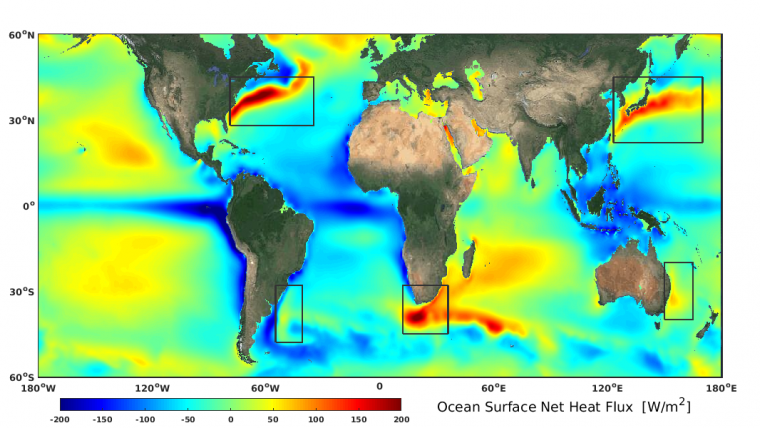Intensification and Poleward Shift of Oceanic Boundary Currents
As scientists from the Alfred-Wegener-Institute, Germany, have shown in a new study, wind-driven subtropical boundary currents in the northern and southern hemispheres are going to increase in strength by the end of this century. The Kuroshio Current, the Agulhas Current and other oceanic currents are shifting their paths towards the pole and thus carry higher temperatures and the risk of storms to temperate latitudes.
For this study, researchers evaluated a wealth of independent observational data and climate simulations. They showed the same pattern for all boundary currents, with the Gulf Stream as the only exception. According to the data, the latter will weaken over the next decades. The study has been published in the Journal of Geophysical Research professional journal.
Along the eastern coasts of South Africa, Asia, Australasia, and South America, weather and climate will get significantly warmer over the next 100 years and thus presumably also significantly stormier on global average. The reason for this are changes to the western boundary currents that are already beginning to have a significant impact on weather events in these coastal regions.
Surface Currents Driven by Wind
These surface currents are driven by the wind; with flow speeds of up to nine kilometres per hour, they are amongst the fastest ocean currents in the world. They reach down to a depth of 1,000 metres and move warm bodies of water from the tropics to the coastal regions of the temperate latitudes. The best-known western boundary current in Europe is the Gulf Stream. Across the world, however, these also include the Kuroshio Current off the coast of Japan, the Brazil Current off the eastern coast of South America, the Eastern Australia Current as well as the Agulhas Current off the coast of South Africa.
Scientists from the Alfred-Wegener-Institute, Helmholtz Centre for Polar and Marine Research (AWI) have discovered these changes in a comparative analysis of eleven independent climate data bases. On the one hand, the scientist evaluated oceanographic observational data as well as satellite data on the currents’ heat loss between 1958 and 2001. On the other, they considered simulations for past and future climates as well as indicators for the flow speed of the currents, for water temperature and air pressure at the sea surface.
Surface Temperature Increase
The analysis shows that the surface temperature of the boundary currents has increased two to three times faster than in other oceanic regions. In addition, the currents release 20 percent more heat than they did half a century ago, which leads to the conclusion that the temperature of the water has risen, its flow speed has increased and the currents thus transfer more water and also more heat from the tropics towards the pole. The cause of these changes were increasing winds in both hemispheres, according to Hu Yang, AWI climate researcher and author of the study.
The greater the heat transfer from the sea, the higher possibly the probability of storms. Prof. Gerrit Lohman, climate modeller at the Alfred-Wegener-Institute and co-author of the study, expects that over the next decades, Japan, China and Korea will need to expect higher air temperatures particularly in winter, because the Kuroshio Current will transport more heat and shift northward with the wind. This heat will change the atmospheric condition in such as way as to make storms more likely in this region. For the Eastern Australian Current, the Brazil Current and the Agulhas Current on the southern hemisphere, the analyses predict a southward shift, because there, too, the winds shift polewar.
Weaker Gulf Stream
Warmer, stronger, poleward - according to the results, this pattern applies to all western subtropical boundary currents. The only exception is the Gulf Stream, that is driven by the wind and coupled with the thermohaline circulation. This is also often referred to as a global conveyor belt. The results indicate that the power of this conveyor belt will weaken in the long term - and in an order of magnitude that more than compensate for the plus of increasing winds. Without the influence of this circulation, the Gulf Stream would follow the same patterns as the other boundary currents.
Hu Yang, Gerrit Lohmann, Wei Wei, Mihai Dima, Monica Ionita, Jiping Liu: Intensification and Poleward Shift of Subtropical Western Boundary Currents in a warming climate, Journal of Geophysical Research, DOI: 10.1002/2015JC011513.

Value staying current with hydrography?
Stay on the map with our expertly curated newsletters.
We provide educational insights, industry updates, and inspiring stories from the world of hydrography to help you learn, grow, and navigate your field with confidence. Don't miss out - subscribe today and ensure you're always informed, educated, and inspired by the latest in hydrographic technology and research.
Choose your newsletter(s)
























